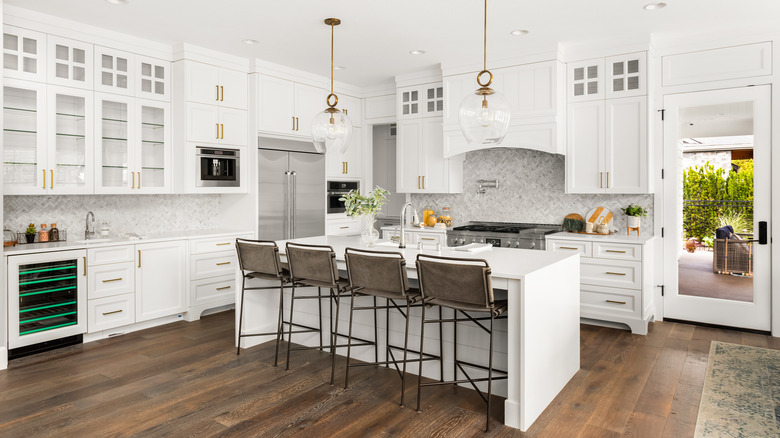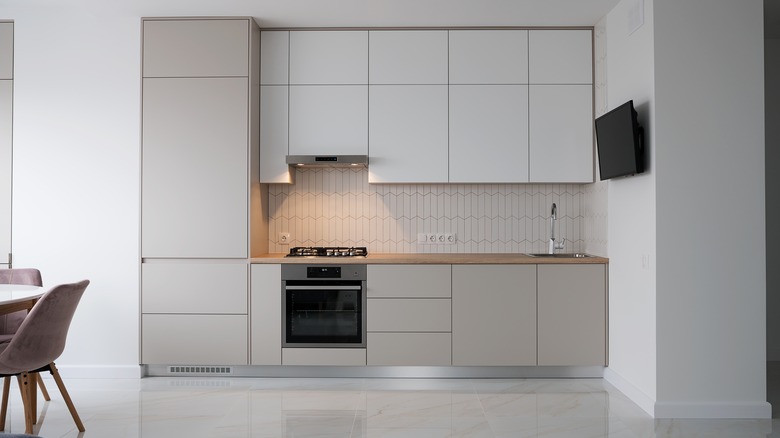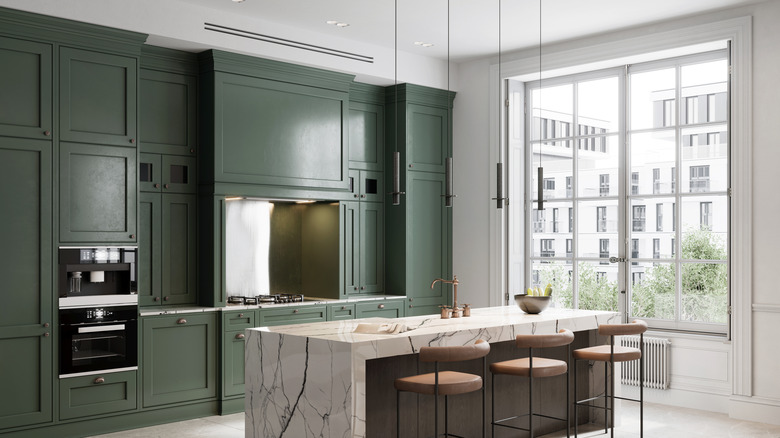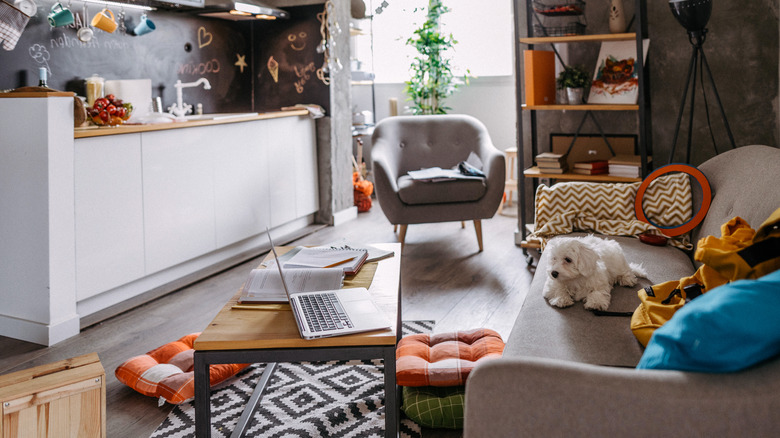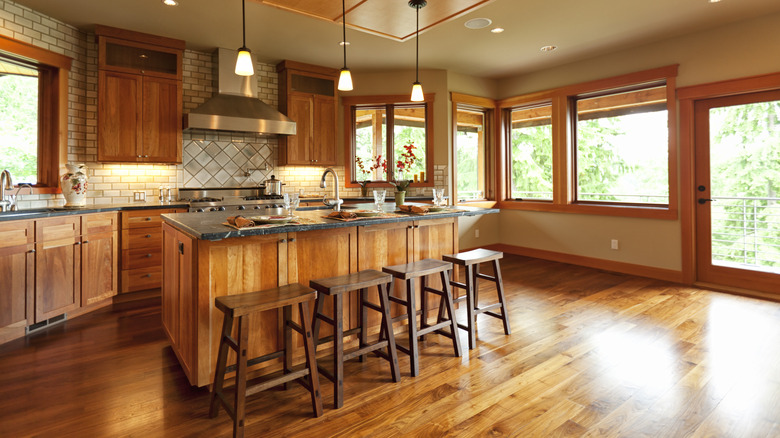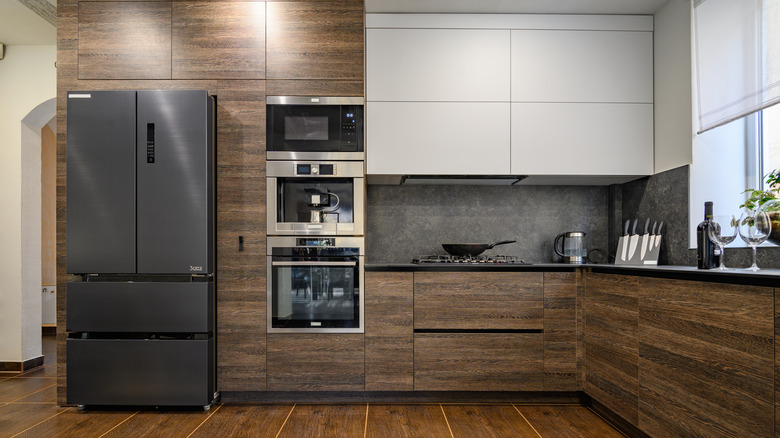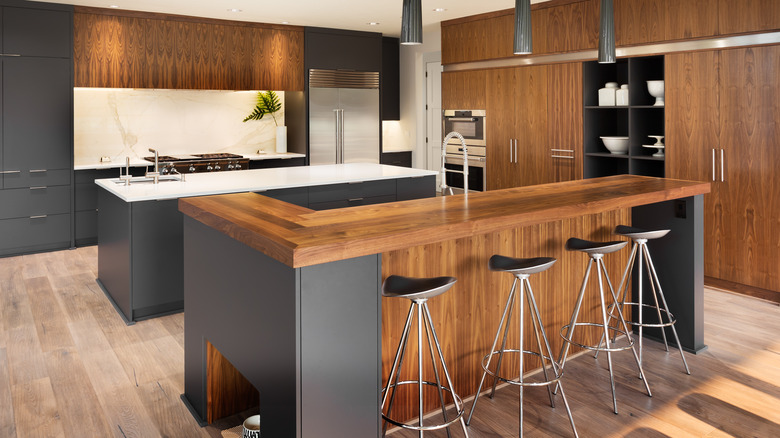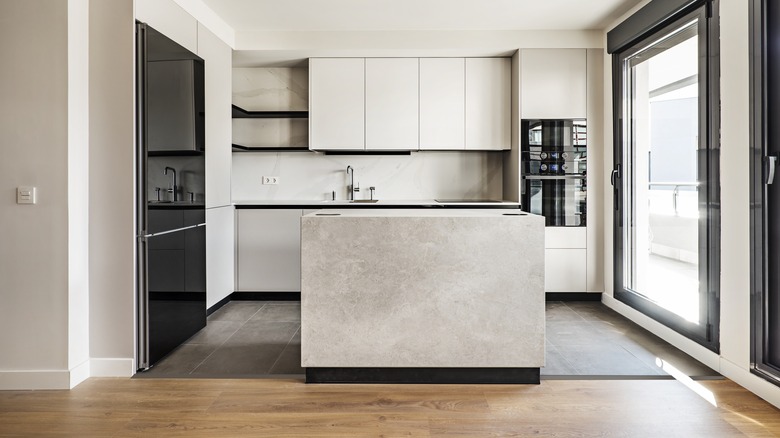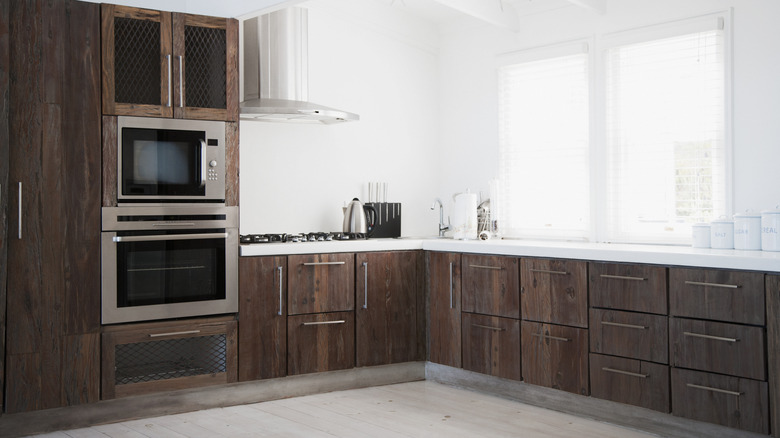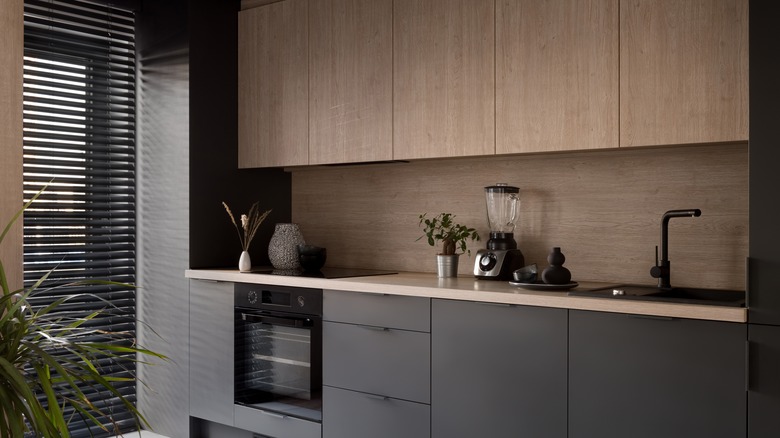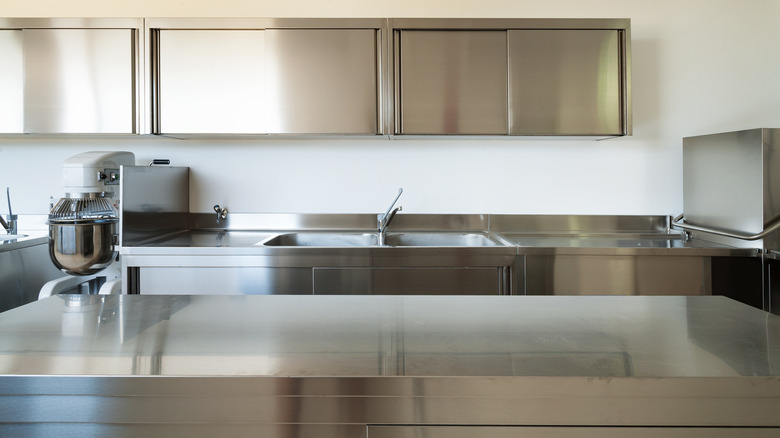10 Of The Most Popular Cabinet Materials (And Which Is Right For You)
When building or remodeling a house, the kitchen is typically where most of a homeowner's time, effort, and budget go. While shiny countertops and appliances garner a lot of attention, cabinetry can be just as impactful — and expensive — when putting a kitchen together. Many people aren't as aware of all the options when it comes to cabinet materials versus countertop options since cabinets aren't seen as quite as glamorous, but a high-quality cabinet finish can be the difference between a good room and a great one.
Working on selecting new kitchen cabinets? Rushing into hardwood or laminate cabinets simply because those options are the most familiar — without fully exploring the other materials on the market — can lead to buyer's remorse. We've rounded up the most popular choices regarding cabinet materials. Consider this your guide to the advantages and disadvantages of each, including durability, cleanability, and price point, so that you can make your purchasing decision with clarity and confidence.
Medium-density fiberboard (MDF)
If you're familiar with engineered hardwood flooring, you probably understand the concept of one of the most popular modern cabinet materials: medium-density fiberboard (MDF). This material is similar to particleboard in that it combines wood byproducts with resin and adhesives, resulting in a solid wood surface. This surface will not have a woodgrain appearance and is quite porous. Therefore, MDF cabinets must either be prime and painted or veneered. This makes them very versatile and usable for any style.
One of the main reasons for the popularity of MDF is its affordability. For a price that is only marginally higher than that of particleboard, MDF cabinets are heavier, sturdier, and more resistant to warping. However, it does come with a few potential drawbacks. Dents, scratches, and chips in MDF cannot be repaired, and the material also struggles to hold nails and screws efficiently. Moisture getting inside chips or dents that have penetrated the paint or veneer can also lead to warping, so replacing damaged doors or cabinets promptly and taking care not to use excessive moisture when cleaning is important.
High-density fiberboard (HDF)
If you're looking for a cabinet material that is more high-end than medium-density fiberboard (MDF) but still more affordable than hardwood, high-density fiberboard (HDF) might be the answer. High-density fiberboard — also known as Masonite — is made the same way MDF is, by combining wood byproducts with resin. However, HDF is created using finer wood fiber and more of it. High-density fiberboard is also compressed using higher pressure, resulting in a denser, harder, stronger, and more durable product.
HDF's hard, compact nature — combined with its high durability — makes it ideal for high-traffic uses like commercial flooring. Those qualities make the material more difficult to work with when manufacturing more intricate products that require more cutting and shaping, such as cabinets. The more compressed fibers of HDF also mean that it does not take on as smooth of a surface as MDF does, making it a bit more difficult to prime and paint or veneer — which remains necessary. While the compact nature of HDF does help with moisture resistance, the difference is marginal, and caution with water is still necessary. Due to the higher cost of manufacturing and the higher level of durability, you will pay a significantly higher price for HDF cabinets than for MDF cabinets.
Low-density fiberboard (particleboard)
Low-density fiberboard — commonly known as particleboard — is another building material created by combining wood byproducts with resin or adhesive. Particleboard is the least compressed of the fiberboard options, making it the least durable, weakest, and most susceptible to water damage. Like all fiberboard cabinets, particleboard cabinets will need to be primed and painted or veneered. However, its lack of moisture resistance means that even the water contained in latex-based paints can be absorbed by the material and cause warping. Strictly oil-based paints should be used on cabinetry or furniture constructed from particleboard. Cleaning should consist of wiping with a slightly damp cloth and drying with a towel afterward.
Other than the fact that particleboard is lightweight, its only real appeal to the masses is its extremely low price. Even supporting the weight of heavy countertops and basic countertop appliances can cause particleboard cabinets to crack over time. If you find yourself in a situation where you are facing a choice between particleboard cabinets and no cabinets at all, particleboard cabinets would be preferable. Overall, however, these cabinets are not a good investment and can even make it harder to sell your home.
Hardwood
Hardwood is the most traditional building material for cabinets. While many modern cabinets might look like solid hardwood, most are actually plywood or fiberboard that has been covered with a woodgrain veneer. Genuine hardwood cabinets are constructed from simple solid wood boards and are typically stained or just sealed to let their natural wood grain shine through (although they can also be painted). This lends perfectly to traditional rustic or rugged industrial style design styles. Different types of wood offer different varieties of grains and natural colors, as well as varying levels of density and durability for wooden cabinets.
Hardwoods like hickory, pecan, or oak are considered the hardest and most durable and are unlikely to chip, scuff, or dent. The denser the wood, the more resistant to moisture damage as well. Some hardwoods — like walnut, cherry, and alder — belong to a slightly softer category of hardwood. However, while slightly more prone to scratching, these softer varieties are still considered highly durable. Hardwood cabinets can also be refinished when wear does become visible, unlike fiberboard options, making them a very popular choice for those who can afford their higher price.
Plywood
The term plywood is sometimes used synonymously with the term particleboard. However, the two are not the same building material. While still a composite material, plywood is considerably higher in quality than particleboard. Unlike particleboard, MDF, and HDF, plywood is not created by compressing wood fiber with resin and adhesives. Instead, multiple thin sheets of natural wood are glued together to form one more durable sheet of plywood. The more sheets that are fused together, the higher the ply of the plywood in question.
Since plywood isn't made from compressed particles, it retains a visible woodgrain pattern. This means plywood cabinets can be stained, sealed, or primed and painted to match any style. They can also be refinished once typical wear and tear becomes visible and are more moisture-resistant than fiberboard options. However, it is important to know the grade of the plywood used in the construction of your cabinets, as lower-grade plywood can eventually split or separate due to adhesive failure. Since it shares many of the benefits of hardwood at a significantly lower price point, plywood is a popular choice among homeowners who want the highest quality they can comfortably afford.
Wood veneer
When discussing cabinet materials, you may have heard of wood veneer as an option. While this isn't wholly incorrect, wood veneer isn't a standalone building material. Wood veneer simply refers to one type of finish that can be applied to cabinets; cabinets can't be built solely from veneer. When a cabinet is constructed out of compressed wood materials — such as MDF, HDF, and particleboard — that do not retain a woodgrain pattern, an ultra-thin sheet of natural wood can adhere to the exposed sides of the cabinet to give it the appearance of solid hardwood. This is a wood veneer.
Wood veneer can be applied to any type of fiberboard cabinet. The finish can also mimic any kind of wood. This allows homeowners with financial limitations to create the appearance of a warm cherry, oak, or other wood-toned luxury kitchen on a fiberboard budget, which is quite appealing to many. While wood veneer does a decent job of protecting the core material beneath it, it is still wood-based and is, therefore, porous and at risk of moisture damage. With time and moisture exposure, wood veneer can peel away from its fiberboard core, split, or bubble.
Melamine
Melamine is a newly popular artificial material consisting of paper, plastic, and resin fused to a fiberboard core. While similar to a veneer, the plastic and resin used in melamine combined with its high-pressure thermal fusing process make it a more permanent and much more durable finish. Melamine cabinets come in various pre-painted solid colors as well as faux woodgrain patterns and colors that can appeal to any décor style.
When it comes to moisture resistance, melamine is about as good as it gets for a wood-based building material. While it is still far from waterproof, melamine will hold up to everyday moisture and regular wipe-downs. For its relatively low price, you can't beat this modern material's durability. However, it isn't without its potential disadvantages. In addition to lacking the potential for refinishing, melamine cabinets are prone to damage when exposed to high heat and also tend to splinter when nails or screws are inserted.
Wood laminate
Much like wood veneer, wood laminate is not a standalone cabinet material. It is, however, a popular finish for wood fiber-based cabinets. The difference between wood laminate and wood veneer is that wood laminate is not made from sheets of natural wood. Instead, wood laminate is layered artificial paper and plastic materials combined with textured high-resolution images that mimic realistic wood grain and a protective outer coating. This is largely the same process used in manufacturing wood laminate flooring.
The appearance of printed woodgrain is more uniform than that of natural woodgrain. Because of this, wood laminate cabinets can appear sleeker and more modern than rustic natural woods like knotty pine or white oak. Wood laminate cabinets are available in many different woodgrain patterns and colors and offer a decent level of water resistance. The fact that they are low-maintenance, easy to clean, and very affordable makes them one of the most popular types of cabinets — despite the fact that they are not heat-resistant and cannot be refinished or easily repaired.
Vinyl laminate
Vinyl laminate is another cabinet finish often referred to as a building material. In reality, vinyl laminate is another material used in combination with a compressed wood fiber product (typically MDF) to create a budget-friendly cabinet that appears to be of higher quality than its core suggests. These finishes can also act as protective barriers for the fiberboard cores present beneath them, providing moisture and stain resistance.
Vinyl laminate combines paper and vinyl into a thin sheet that is thermally applied to a fiberboard core and vacuum sealed. Much like luxury vinyl flooring, these cabinets are available in a variety of high-resolution faux woodgrain patterns. Vinyl is particularly low-maintenance, water-resistant, and easy to clean. However, it is particularly heat-sensitive and can melt when exposed to high temperatures. As with all forms of laminate, there is also a risk of eventual peeling and delamination. However, many homeowners find the low price of vinyl laminate cabinets worth the risk.
Stainless steel
For the ultimate chef's kitchen, no other cabinet material compares to stainless steel. It isn't a coincidence that this is the material found in commercial kitchens; it is completely resistant to heat and water and doesn't hold on to moisture or bacteria. Stainless steel is also easy to clean and can be fully sanitized using high-heat steam and chlorine bleach, which should not be used on wood. As its name suggests, it is highly metallic and sleek, making it most suitable for ultra-modern, industrial-style kitchens.
While stainless steel cabinets are scratch and dent-resistant, they aren't impervious to damage. The main advantage is that a scratch on your stainless steel cabinet won't become a passageway for moisture that will destroy the wood or fiberboard beneath its surface the way it would with a wood cabinet. It's also important to note that while stainless steel is beloved for how easy to clean and sanitize it is, you'll likely find yourself needing to clean it more often since smudges and fingerprints are more visible. Luckily, there are many inexpensive and unexpected ways to make your stainless steel shine. The main disadvantage of stainless steel countertops is their very high price point; they are typically even more expensive than hardwood models.

